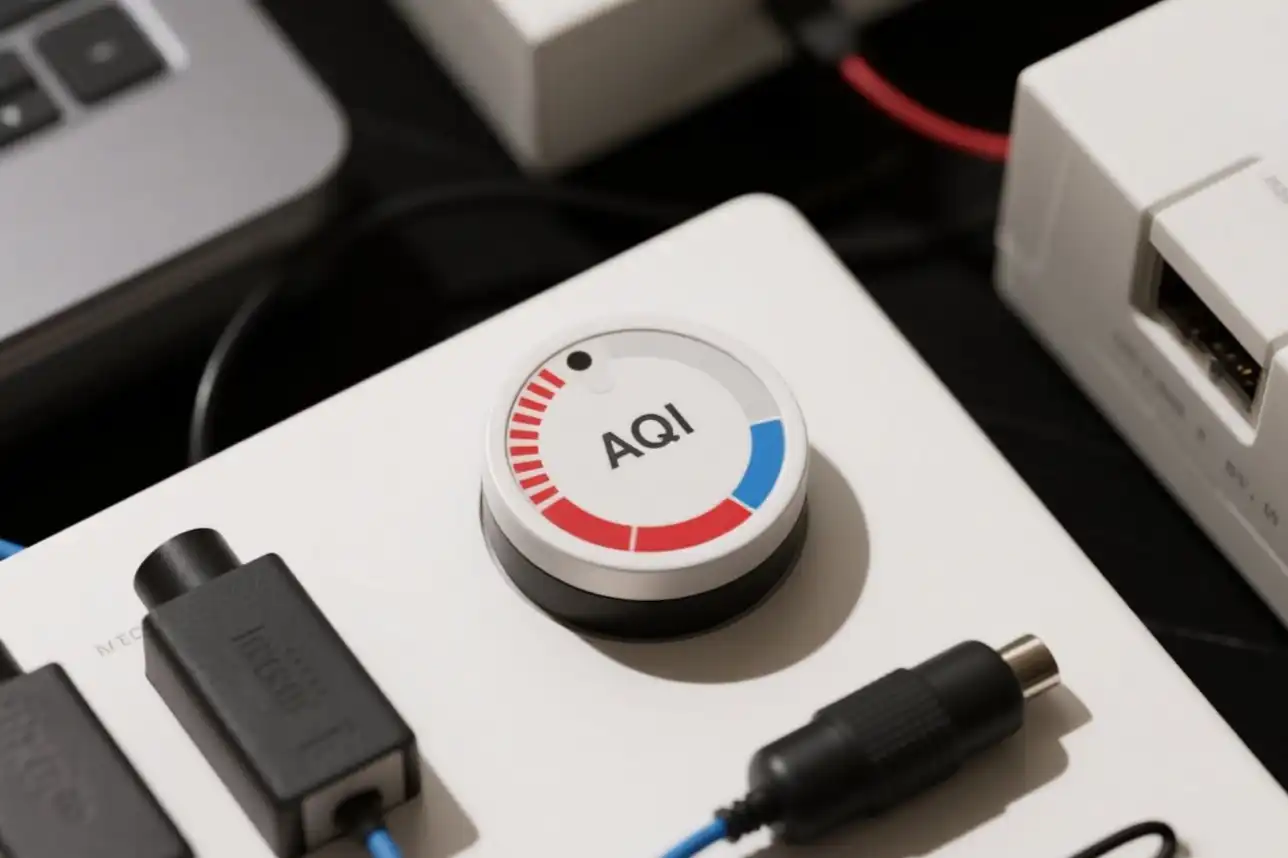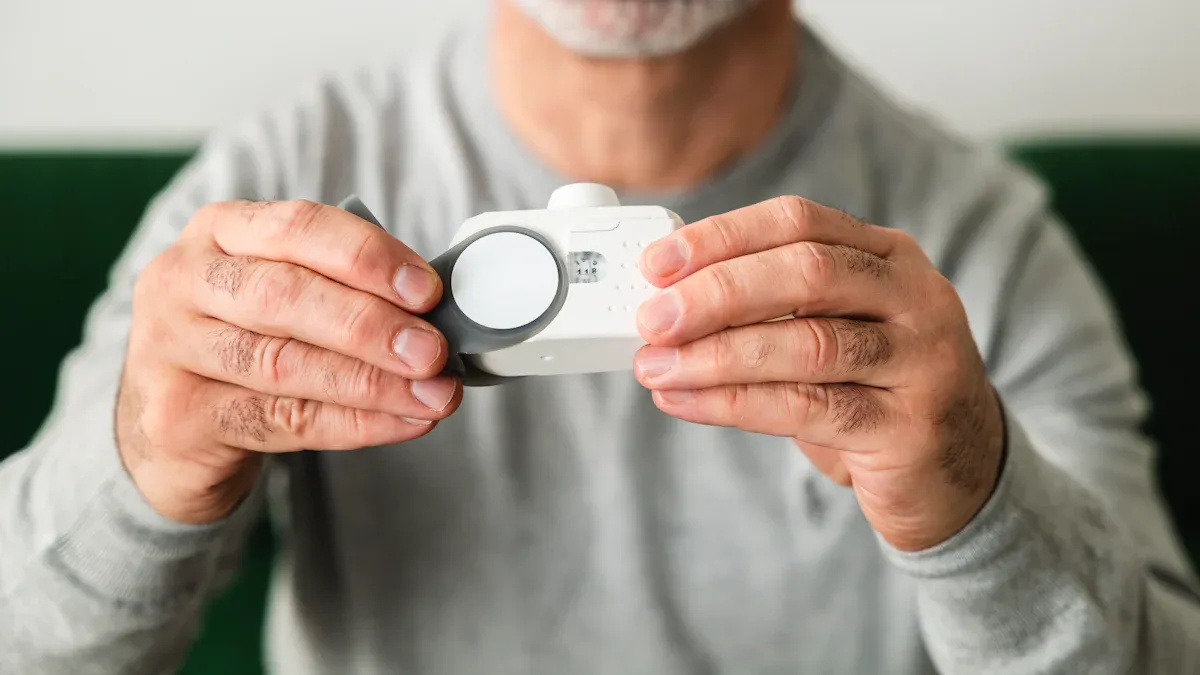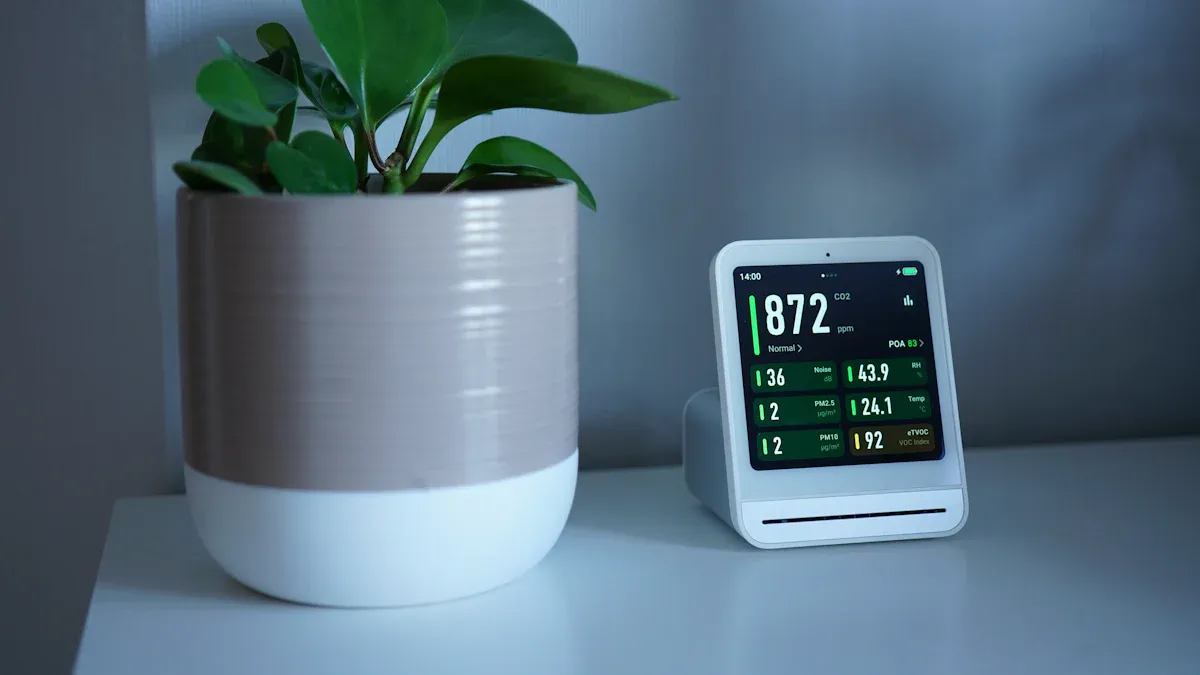
You want to keep your indoor air clean and safe. Today, many people use AQI sensors because they make air quality monitoring simple and affordable.
- In the last five years, low-cost AQI sensors have become much more popular.
- Projects like Purple Air and AirVisual now help thousands of users track air quality in real time.
The application of AQI sensors in air purifiers lets you see changes in your air and take action quickly. You do not need special skills to use these tools.
Key Takeaways
- AQI sensors help you check air quality inside your home. They show you pollution levels right now.
- When you use AQI sensors in air purifiers, the device can change fan speed by itself. This saves energy and keeps the air clean.
- Put AQI sensors in rooms you use a lot. Place them at the height where you breathe. Keep them away from windows or vents for good results.
- Look at your AQI sensor every day. Clean and adjust it often to keep the data correct. This helps you notice air changes early.
- If AQI numbers go up, act fast. Use air purifiers, open windows, and stay away from things that make indoor air dirty.
AQI Sensors Overview

What Is AQI?
You might notice AQI numbers on weather apps or TV news. AQI means Air Quality Index. This number shows if your air is clean or dirty. The AQI scale goes from 0 up to 500. A low number means the air is clean. A high number means there is more pollution and it can be bad for your health.
AQI looks at six main pollutants:
- Ozone (O₃)
- Particulate matter (PM2.5 and PM10)
- Carbon monoxide (CO)
- Sulfur dioxide (SO₂)
- Nitrogen dioxide (NO₂)
Each pollutant has a safe amount you should not go over. AQI sensors check how much of each pollutant is in the air for a set time, like one hour or one day. The highest reading from these pollutants becomes the AQI for that time. For example, if PM2.5 is the highest, the AQI will show that.
Tip: AQI numbers have color codes. Green means the air is good. Red or purple means you should stay inside more.
How AQI Sensors Work
AQI sensors use different ways to find pollutants in the air. There are two main kinds of AQI sensors:
- RS485 AQI Sensors: These sensors use wires and a special way to talk to other devices. They work well in places like factories or where WiFi does not work well.
- WiFi AQI Sensors: These sensors do not need wires. They send data to your phone or computer. They are easy to use and good for smart homes.
Sensors use different methods to find pollutants:
- Lasers look for small particles like PM2.5 and PM10.
- Ionization and photoelectric detectors can find smoke.
- Some sensors even use satellite data to check the air.
| Sensor Type | Target Pollutants | Detection Range |
|---|---|---|
| Laser Dust Sensors | PM1.0, PM2.5, PM10, PM4.25 | 0-1000 μg/m³ |
| Ozone Sensors | Ozone (O₃) | 0-2 ppm, 10-1000 ppb |
These sensors give you real-time data. You can see changes in air quality right away and act fast. You should calibrate your sensor often to keep it working well, especially for small particles like PM2.5.
Application of AQI Sensors in Air Purifiers

Real-Time Air Quality Monitoring
You can use the application of AQI sensors in air purifiers to check your indoor air all the time. These sensors measure things like PM2.5, PM10, ozone, carbon dioxide, radon, and VOCs. They use lasers, ionization, or photoelectric ways to get this data. The air purifier shows you the results as a number or color. This helps you know if your air is clean or dirty right away.
If the AQI sensor finds more pollution, the air purifier reacts fast. Some models connect to WiFi or apps, so you can see your air quality anywhere. This real-time info helps you act quickly to stay healthy. You can watch the air get better as the purifier works. This makes you feel safe and calm.
Tip: Put your air purifier in the room you use most. This helps the AQI sensor give you the best information.
Automatic Fan Speed Adjustment
The application of AQI sensors in air purifiers also helps save power. When the sensor finds more pollution, the fan goes faster to clean the air. If the air is already clean, the fan slows down or stops. For example, the Levoit Vital 200S uses an infrared sensor to find pollution and changes the fan speed by itself. The Mila air purifier uses many sensors to do this too. It even has an Energy Save Mode that turns off the fan when the AQI is zero.
This smart change means your air purifier only works as much as needed. You do not waste power running the fan fast all the time. Your home is also quieter when the air is clean. The application of AQI sensors in air purifiers makes your device work better and helps you pay less for energy.
Benefits and Limitations
The application of AQI sensors in air purifiers gives many health benefits. You get cleaner air because the purifier removes dust, pollen, VOCs, pet dander, and smoke as soon as the sensor finds them. This can help you breathe better, have fewer asthma attacks, and sleep well. Cleaner air can also help your skin and make you feel less stressed. Using an air purifier with real-time checks gives you a healthier home and may save you money on doctor visits.
- Health Benefits:
- Less allergens and irritants in the air
- Lower chance of asthma attacks
- Better sleep and skin
- Less stress and better mood
But there are some limits. Many home AQI sensors use simple tech. They may not find every kind of pollution, like very tiny particles or some VOCs. Sometimes, the numbers are not exact because of bad calibration or where you put the device. Some sensors only show changes in air quality, not the exact amount of each pollutant. This can make it hard to know if the air is really safe.
| Benefit | Limitation |
|---|---|
| Real-time feedback | May miss ultrafine particles |
| Automatic fan adjustment | Needs regular calibration |
| Improved health and comfort | Accuracy varies by device and placement |
| Energy savings | Limited detection range for some pollutants |
Note: The application of AQI sensors in air purifiers works best if you keep the sensor clean and check its calibration often. Try not to put your air purifier near windows or vents for the best results.
Monitoring Steps
Choosing a Sensor
You want an AQI sensor that fits your needs and home. Start by thinking about what you want to measure. Some sensors check for particulate matter like PM1, PM2.5, and PM10. Others also measure gases such as VOCs, CO2, formaldehyde, ozone, and nitrogen dioxide. For indoor use, focus on sensors that detect VOCs, CO2, humidity, and harmful gases from household products. If you plan to use the sensor outside, look for models that track PM2.5, PM10, ozone, and nitrogen dioxide.
- Look for sensors with third-party accuracy tests or certifications.
- Check if the sensor connects to your phone or smart home system.
- Think about battery life, portability, and how easy it is to use.
- Make sure the sensor is easy to calibrate and maintain.
- Consider the cost. Some sensors cost a few hundred dollars, while advanced models with more features and better accuracy can cost thousands.
Tip: Choose a sensor that matches your main concerns, such as allergies, ventilation, or pollution from outside.
Placement Tips
Where you put your AQI sensor matters. Good placement helps you get the most accurate readings.
- Place sensors in rooms you use most, like bedrooms or living rooms.
- Keep the sensor at breathing height—about 3 to 6 feet above the floor.
- Avoid putting sensors near windows, doors, air vents, or air purifiers. These spots can give false readings.
- Make sure nothing blocks the sensor. Do not hide it behind furniture or in corners.
- Use more than one sensor if you want to check air quality in different rooms or on different floors.
| Good Placement | Poor Placement |
|---|---|
| Living room, bedroom | Near window or vent |
| 3–6 feet above floor | Behind furniture |
| Open area | In a corner |
Note: Following these tips helps you get a true picture of your indoor air.
Reading AQI Data
Check your AQI sensor data every day. Air quality can change quickly because of weather, cooking, or outdoor pollution. Daily checks help you spot problems early and take action, like turning on your air purifier or opening a window.
When you read the numbers, remember that sensors can make mistakes. Sometimes, you might see a sudden spike or drop. This could be from a sensor error, a draft, or even a cooking event. Do not panic if you see an outlier. Look for patterns over time instead of focusing on one strange reading.
- Watch for big changes in AQI numbers.
- Compare readings from different rooms if you use more than one sensor.
- Clean and calibrate your sensor as needed to keep it accurate.
Tip: Use your sensor’s app or display to track trends. This helps you understand what affects your air and when you need to act.
Interpreting and Acting on AQI Readings
Understanding AQI Levels
You can use AQI readings to see if your air is safe. AQI stands for Air Quality Index. This number tells you if the air is clean or dirty. The table below explains what each AQI range means for your health:
| AQI Category | AQI Range | Health Implications |
|---|---|---|
| Good | 0 – 50 | Air quality is excellent; poses little or no health risk. |
| Moderate | 51 – 100 | Acceptable air quality; some health concern for unusually sensitive individuals; general population unlikely affected. |
| Unhealthy for Sensitive Groups | 101 – 150 | Sensitive groups (children, older adults, people with lung diseases, active outdoors) may experience health effects; general population unlikely affected. |
| Unhealthy | 151 – 200 | Active individuals outdoors may experience respiratory effects; sensitive groups likely to experience more severe effects. |
| Very Unhealthy | 201 – 300 | Widespread health effects expected in general population; more serious effects in sensitive groups; increased medical visits. |
| Hazardous | 301 – 500 | Health warnings of emergency conditions; widespread media coverage; strong recommendations to reduce exposure. |
Tip: AQI sensors use colors to show air quality. Green means the air is good. Red or purple means you should protect your health.
Recommended Actions
If your AQI sensor shows a high number, you need to act. Cooking, cleaning, or smoking inside can make AQI go up. Bad airflow and some home products also add pollution. Try these steps when AQI is high:
- Stay inside and close all doors and windows tight.
- Use tape or weather strips to seal any gaps.
- Run air purifiers with HEPA filters to catch dust.
- Upgrade HVAC filters to better ones.
- Do not burn candles, wood, or smoke inside.
- Wear an N95 mask if you must go outside.
- Do fewer outdoor activities, especially for kids, older people, or those with health problems.
- Watch for air quality alerts and change your plans if needed.
Note: If you feel very tired or have trouble breathing, call your doctor.
Improving Indoor Air
You can make your indoor air better with some easy steps. The best way is to remove things that pollute your air, like tobacco, gas stoves, or strong cleaners. Letting in fresh air helps too. Open windows or use fans when the outdoor AQI is good. Air purifiers with HEPA filters take out dust, smoke, and pollen. Small air cleaners can lower dust by up to 65%. Using both fresh air and filters works best.
Plants like spider plants or snake plants can help a little. They work slowly, so use them with other ways. DIY air cleaners, like Corsi-Rosenthal Boxes, are a cheap way to clean air at home or school.
Tip: Check your AQI sensor often. Use the numbers to know when to open windows, run your purifier, or stop some indoor activities. This keeps your air clean and your family healthy.
You can protect your health by using AQI sensors to check your air every day.
- Watch for changes in AQI numbers and act fast if they rise.
- Place sensors in the right spots and keep them clean.
- Change filters and calibrate sensors often.
- Use the application of AQI sensors in air purifiers to keep air fresh and safe.
| Benefit | Result |
|---|---|
| Cleaner air | Fewer allergies and headaches |
| Real-time monitoring | Quick action for your family |
| Smart adjustments | Better sleep and comfort |
Stay alert to AQI readings. Small steps today can lead to a healthier home tomorrow. 🌱
FAQ
How often should you check your AQI sensor?
You should check your AQI sensor at least once a day. Air quality can change quickly. Checking often helps you spot problems early and keep your home safe.
Do AQI sensors need maintenance?
Yes, you need to clean and calibrate your AQI sensor. Dust can block the sensor and make readings less accurate. Follow the instructions from the manufacturer for best results.
Can you use one AQI sensor for your whole house?
One sensor works for a small space. For larger homes, you should use more than one sensor. Place sensors in rooms you use most, like bedrooms and living rooms.
What do you do if your AQI reading is always high?
First, check if your sensor is clean and placed correctly.
Next, use an air purifier and open windows when outdoor air is good.
If the reading stays high, look for sources of pollution like smoking, cooking, or strong cleaners.
See also
Comparing Air Filters and Other Dust Removal Methods
How Sinus Air Purifiers Impact Allergy and Sinus Health
Do Air Cleaners Really Help with Allergies What Experts Say
What Science Says About Air Purifiers for Sinus and Allergy Symptoms
